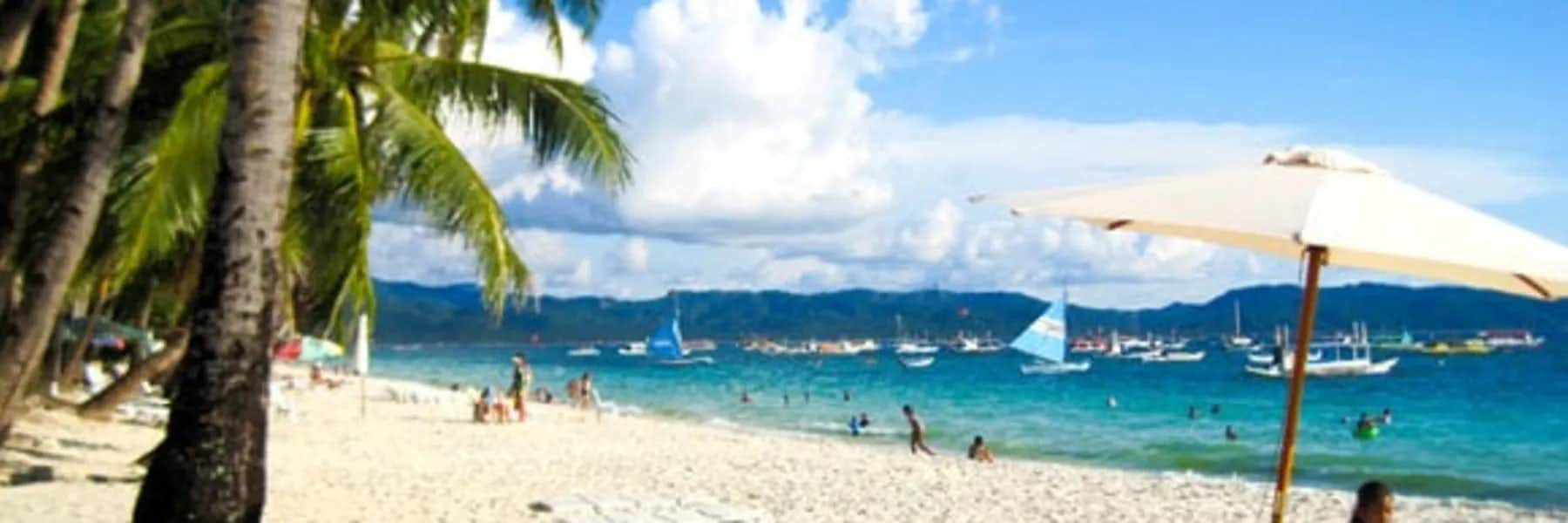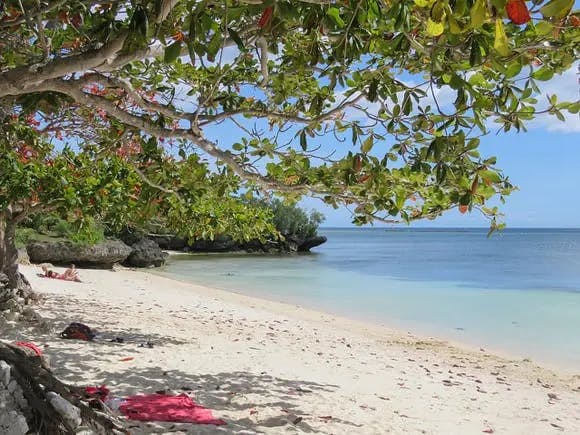I’ve heard about the sunsets here. At first, rays of gold and fuchsia shoot down from the sky. White deck chairs, cabanas, and boardwalk bars are thrust into a rose-tinted world.
At the last minute, the setting sun changes from tangerine to blood orange…then a lurid flicker of red disappears out on the horizon. A 50-minute flight from the capital, Manila, the Philippine island of Boracay is a place of in-your-face beauty. There’s no waiting to get to the beach to see if the stories are true. The minute you step off the plane, you can see that the postcards don’t do it justice. The sands are as white as they say, if not whiter…a pearly glitter that stays cool under your feet.
If you come here, you’re likely to stay on White Beach, as most of the little beach hotels are located here. (There are resorts elsewhere on the island, but I don’t feel they are worth shelling out the extra cash for.) The beach is about two-and-a-half miles long, but the locals have divided it into thirds, with sections referred to as Boat Stations.
I’ve booked a room at expat-owned Dave’s Straw Hat Inn, at Station One. The beach is a minute’s walk from the inn’s entrance, and the entire Station gets dark and quiet after 9 p.m.
The nightlife is a half-mile northwest at Station Two, where you’ll find the commercial strip referred to as D’Mall. (Station Three is more local than commercial, though there are a few resorts.)
Though there are plenty of foreign visitors here every day, most of the tourists are Filipinos. There’s a full-time expat community of folks from North America, Australia, the U.K., and more. One Brit I met has a software company incorporated in Hong Kong—he and his wife run it from Boracay, where they say the Internet service is good enough to meet their daily business needs.
An American woman, Lee Rosaia, moved from California with her adult daughter and started one of the island’s first cafés. You’ll meet people who live off businesses they can run from anywhere—from online poker to trading shares—as well as those who’ve opted for brick-and-mortar businesses on the island. And there are a fair few retirees who live here full- or part-time.
A perfect day might start early with a walk along the beach. It is usually quite empty apart from a few joggers. Get a California-style breakfast at Real Coffee—try the pesto omelet—and then maybe take a quick dip. Stay out of the noontime sun—midday is a good time to pull out the laptop and get some work done or just reconnect with family and friends. For lunch take your pick of home-style Filipino eateries, where two can eat for less than $3.
If you enjoy diving, there are more than 30 dive sites less than an hour’s boat ride from Boracay. For a day trip, try a bit of island-hopping. Crystal Cove is a favorite…the caves sport fun crystal formations and the water’s great for snorkeling ($5 entry fee). If you’re into adventure, go kite boarding or wind surfing on Boracay’s Bulabog Beach. Or spend the day relaxing with a massage from one of the many parlors and spas (from about $7 at the beachside stations). There’s also zip-lining, golfing, jungle trekking and fishing.
You won’t find opera or ballet here, but there are some great restaurants, live bands, and plenty of karaoke, one of the favorite national pastimes. A night out can be as expensive or as affordable as you want it to be—spend no more than $10 on Mongolian barbecue or ubiquitous “buy one, take one” cocktail deals, or splurge on wine and pasta at Aria for $20.
In the Americas a beach half as beautiful as Boracay would be prohibitively expensive for full-time living. But here you can rent a two-bedroom apartment for about $700 a month…solid construction, WiFi connection, and gleaming new tiles and finishes. And though there may not be as much property for under $100,000 as there used to be, the bang-for-the-buck factor is undeniable, with a range of condos from about $150,000 to $350,000.
Living here is affordable—for instance, you can get a full-time maid for under $100 a month—and it’s also getting convenient. A few of the “old-timer” expats remember when Boracay didn’t have electricity or, later, when Internet service was first introduced. But these days, utilities and services are present and reliable.
You may still find that getting specific things at local shops—a favorite shower gel or wine—is difficult. Boracay is a small island. But to the expats living here, it doesn’t matter, because the real reason they stay is the people. “This is the friendliest place on earth,” says expat Martin Hunter. Filipinos are well educated, polite, and relaxed. It’s easy to pick up enough words in the local Tagalog language to impress your new neighbors and make friends. And as nearly everyone here speaks English, it’s a comfortable place to live.




